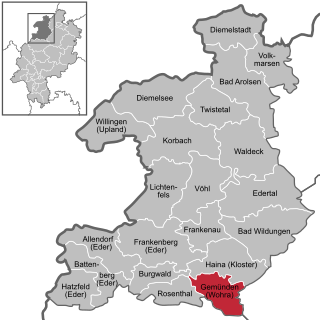
Worms is a city in Rhineland-Palatinate, Germany, situated on the Upper Rhine about 60 km (40 mi) south-southwest of Frankfurt am Main. It had about 82,000 inhabitants as of 2015.

Eschwege, the district seat of the Werra-Meißner-Kreis, is a town in northeastern Hesse, Germany. In 1971, the town hosted the eleventh Hessentag state festival.

Heppenheim (Bergstraße) is the seat of Bergstraße district in Hesse, Germany, lying on the Bergstraße on the edge of the Odenwald. It is the birthplace of 4-time Formula One World Champion Sebastian Vettel.

Waldeck is a small town in Waldeck-Frankenberg district in northwestern Hesse, Germany.

Sušice is a town in Klatovy District in the Plzeň Region of the Czech Republic. It has about 11,000 inhabitants. It lies on the Otava River, some 60 km (37 mi) to the south of the regional capital of Plzeň. The town centre is well preserved and is protected by law as an urban monument zone.

Aach is a municipality in the German state of Rhineland-Palatinate. It is part of Trier-Land, a Verbandsgemeinde.

Neustadt is a town in the Marburg-Biedenkopf district in Hesse, Germany. For the town of the same name in Canada see Neustadt, Ontario.

Guxhagen is a community in Schwalm-Eder district in northern Hesse, Germany.

Rotenburg an der Fulda is a town in Hersfeld-Rotenburg district in northeastern Hesse, Germany lying, as the name says, on the river Fulda.

Bad König is a town and resort (Kurort) in the central Odenwald in the Odenwaldkreis (district) in Hesse, Germany, 29 km southeast of Darmstadt.

Gemünden is a town in Waldeck-Frankenberg district in Hesse, Germany.

The four-castle town of Neckarsteinach lies on the Neckar in the Bergstraße district in the southernmost part of Hesse, Germany, 15 km east of Heidelberg.

Haina (Kloster) is a community in Waldeck-Frankenberg in northwest Hesse, Germany.

Beselich is a community in Limburg-Weilburg district in Hesse, Germany.

Kleinheubach is a market community in the Miltenberg district in the Regierungsbezirk of Lower Franconia (Unterfranken) in Bavaria, Germany and the seat of the like-named Verwaltungsgemeinschaft. It has a population of around 3,600.

Schenklengsfeld is a community in Hersfeld-Rotenburg district in eastern Hessen, Germany lying roughly 30 km northeast of Fulda and 60 km southeast of Kassel.

Becherbach bei Kirn is an Ortsgemeinde – a municipality belonging to a Verbandsgemeinde, a kind of collective municipality – in the Bad Kreuznach district in Rhineland-Palatinate, Germany. It belongs to the Verbandsgemeinde Kirner Land, whose seat is in the town of Kirn. Becherbach bei Kirn should not be confused with Becherbach. Becherbach bei Kirn has borne the tag “bei Kirn” since 1 July 1969, at which time both municipalities found themselves in the same district as a result of administrative reform.

Guldental is an Ortsgemeinde – a municipality belonging to a Verbandsgemeinde, a kind of collective municipality – in the Bad Kreuznach district in Rhineland-Palatinate, Germany. It belongs to the Verbandsgemeinde Langenlonsheim-Stromberg, whose seat is in Langenlonsheim. With a population of some 2,900 inhabitants, Guldental is the biggest rural winegrowing community on the Nahe.

Rümmelsheim is an Ortsgemeinde – a municipality belonging to a Verbandsgemeinde, a kind of collective municipality – in the Bad Kreuznach district in Rhineland-Palatinate, Germany. It belongs to the Verbandsgemeinde Langenlonsheim-Stromberg, whose seat is in Langenlonsheim. Rümmelsheim is a winegrowing village.

Hohenroda is a municipality in Hersfeld-Rotenburg district in eastern Hesse, Germany lying right on the boundary with Thuringia.
























